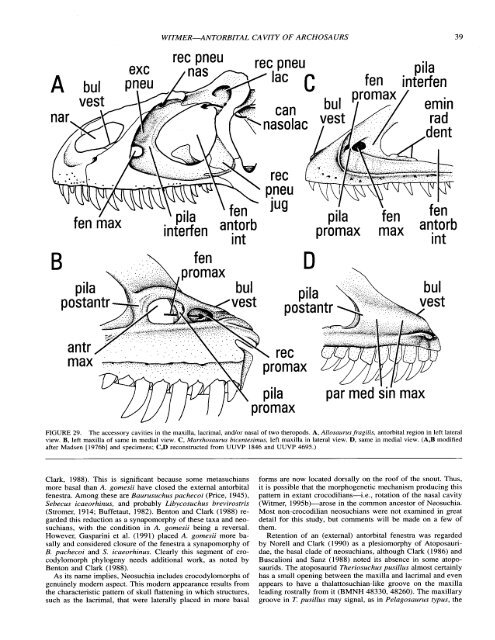Memoir cover 0.tif - Ohio University College of Osteopathic Medicine
Memoir cover 0.tif - Ohio University College of Osteopathic Medicine
Memoir cover 0.tif - Ohio University College of Osteopathic Medicine
You also want an ePaper? Increase the reach of your titles
YUMPU automatically turns print PDFs into web optimized ePapers that Google loves.
WITMERANTORBITAL CAVITY OF ARCHOSAURS<br />
lral I<br />
- . ...<br />
rad<br />
/ dent<br />
fen<br />
D<br />
I<br />
rec<br />
fl;\''<br />
- -<br />
\..rA..Hn.I<br />
pila<br />
~IUlIldA<br />
par med sin max<br />
FIGURE 29. The accessory cavities in the maxilla, lacrimal, and/or nasal <strong>of</strong> two theropods. A, Allosaurus fragilis, antorbital region in left lateral<br />
view. B, left maxilla <strong>of</strong> same in medial view. C, Marshosaurus bicentesimus, left maxilla in lateral view. D, same in medial view. (A,B modified<br />
after Madsen [1976b] and specimens; C,D reconstructed from UUVP 1846 and UUVP 4695.)<br />
Clark, 1988). This is significant because some metasuchians<br />
more basal than A. gomesii have closed the external antorbital<br />
fenestra. Among these are Baurusuchus pachecoi (Price, 1945),<br />
Sebecus icaeorhinus, and probably Libycosuchus brevirostris<br />
(Stromer, 1914; Buffetaut, 1982). Benton and Clark (1988) regarded<br />
this reduction as a synapomorphy <strong>of</strong> these taxa and neosuchians,<br />
with the condition in A. gomesii being a reversal.<br />
However, Gasparini et al. (1991) placed A. gomesii more basally<br />
and considered closure <strong>of</strong> the fenestra a synapomorphy <strong>of</strong><br />
B. pachecoi and S. icaeorhinus. Clearly this segment <strong>of</strong> crocodylomorph<br />
phylogeny needs additional work, as noted by<br />
Benton and Clark (1988).<br />
As its name implies, Neosuchia includes crocodylomorphs <strong>of</strong><br />
genuinely modem aspect. This modem appearance results from<br />
the characteristic pattern <strong>of</strong> skull flattening in which structures,<br />
such as the lacrimal, that were laterally placed in more basal<br />
forms are now located dorsally on the ro<strong>of</strong> <strong>of</strong> the snout. Thus,<br />
it is possible that the morphogenetic mechanism producing this<br />
pattern in extant crocodilians-i.e., rotation <strong>of</strong> the nasal cavity<br />
(Witmer, 1995b)-arose in the common ancestor <strong>of</strong> Neosuchia.<br />
Most non-crocodilian neosuchians were not examined in great<br />
detail for this study, but comments will be made on a few <strong>of</strong><br />
them.<br />
Retention <strong>of</strong> an (external) antorbital fenestra was regarded<br />
by Norell and Clark (1990) as a plesiomorphy <strong>of</strong> Atoposauridae,<br />
the basal clade <strong>of</strong> neosuchians, although Clark (1986) and<br />
Buscalioni and Sanz (1988) noted its absence in some atoposaurids.<br />
The atoposaurid Theriosuchus pusillus almost certainly<br />
has a small opening between the maxilla and lacrimal and even<br />
appears to have a thalattosuchian-like groove on the maxilla<br />
leading rostrally from it (BMNH 48330, 48260). The maxillary<br />
groove in T. pusillus may signal, as in Pelagosaurus typus, the
















